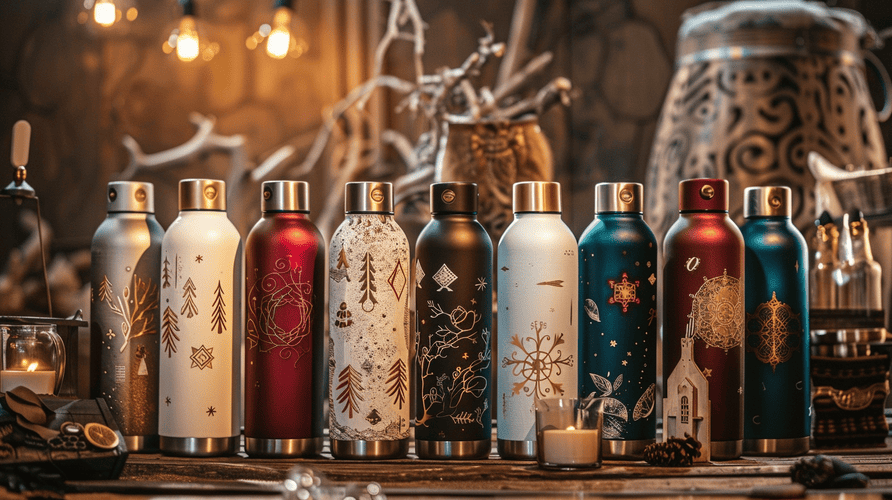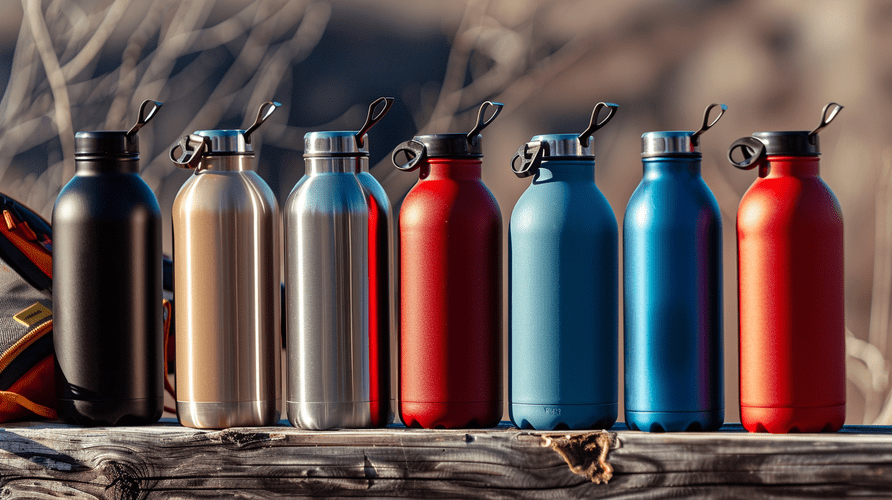Choosing the wrong bottle wastes money and harms the planet. Feeling overwhelmed by options and "eco" claims? Let's find truly sustainable choices together for your hydration needs.
To choose sustainable insulated bottles in 2025, focus on the material (like durable stainless steel), responsible manufacturing processes, the bottle's expected lifespan, and how easily it can be recycled or disposed of at the end of its life. Prioritize longevity and minimal environmental impact.

Making the right choice feels good, both for your wallet and the environment. As someone who deals with stainless steel bottles daily at Icobottle, I know the details matter. We want bottles that perform well, last long, and are genuinely better for our planet. Let’s break down exactly what to look for, so you can feel confident in your next wholesale purchase or personal choice. It's about more than just carrying water; it's about making a responsible decision.
How do I choose an insulated water bottle?
Are you confused by all the insulated bottle choices out there? Buying the wrong one means drinks don't stay hot or cold, or worse, it breaks quickly. Let's simplify this.
When choosing an insulated bottle, check the insulation type (vacuum is best), material quality (food-grade stainless steel is durable and safe), lid design (leak-proof?), capacity (match your needs), and how easy it is to clean for long-term use.

Choosing the right insulated bottle ensures your drinks stay at the desired temperature for hours and that the bottle lasts a long time. This is crucial whether you're buying for your company's employees or sourcing products for resale like my client Mark in Canada often does. He needs reliability. Here’s a deeper look at the key factors:
Insulation Performance Matters
The magic behind keeping drinks hot or cold is usually vacuum insulation1. This means there's a space between the inner and outer walls of the bottle with almost no air. Heat struggles to travel through this vacuum.
- Look for: Double-wall vacuum insulation. This is the standard for good thermal performance.
- Why it's important: Better insulation means less need to rely on disposable cups or repurchase drinks when yours gets lukewarm. It performs consistently.
Material Quality is Key
The most common material for durable insulated bottles is stainless steel, specifically food-grade types like 18/8 (also known as 304).
- Benefits:
- Durability: Resists dents and scratches better than plastic or glass.
- Safety: Doesn't leach chemicals like BPA. It's non-reactive, so it won't retain tastes or odors.
- Longevity: A well-made steel bottle can last for many years.
- What to check: Ensure it's specified as food-grade stainless steel2. This is a non-negotiable for me at Icobottle.
Lid Functionality and Design
A leaky lid ruins the whole experience. Consider how the bottle will be used.
- Types: Screw-on lids are simple and often very secure. Flip lids, spout lids, or straw lids offer easier access, especially during activities.
- Look for: Leak-proof or leak-resistant seals. Check reviews if possible. Consider if replacement lids are available, which adds to sustainability.
Capacity and Ease of Cleaning
Choose a size that fits the intended use – smaller for daily commutes, larger for hikes or long days. Also, think about cleaning.
- Wide mouth openings: Generally easier to clean by hand or with a brush. Some bottles are dishwasher safe, but handwashing often preserves the finish longer.
- Hygiene: Regular cleaning prevents bacteria growth and ensures the bottle lasts.
| Feature | Key Consideration | Why It Matters for Choice |
|---|---|---|
| Insulation | Double-wall vacuum | Temperature retention, usability |
| Material | Food-grade Stainless Steel (18/8) | Durability, safety, longevity |
| Lid | Leak-proof, suitable type | Convenience, prevents spills |
| Capacity | Matches user needs | Practicality |
| Cleaning | Ease of access (e.g., wide mouth) | Hygiene, long-term maintenance |
What makes a water bottle eco-friendly?
Do you see "eco-friendly" everywhere but wonder what it really means for a water bottle? Buying based on vague claims can lead to supporting practices that aren't truly sustainable. Let's clarify.
An eco-friendly water bottle uses durable, reusable materials like stainless steel, involves responsible manufacturing, reduces waste through longevity, is recyclable at end-of-life, and has a lower overall carbon footprint compared to single-use plastics.

The term "eco-friendly" gets thrown around a lot, sometimes without much substance – a practice called greenwashing. For a water bottle to be genuinely eco-friendly, several aspects of its lifecycle must be considered. It's not just about being reusable; it's about the bigger picture. As a manufacturer, I believe transparency here is vital, especially when dealing with knowledgeable buyers like Mark who value genuine quality and sustainability.
Material Impact
The material is the foundation.
- Stainless Steel: Highly durable, meaning it lasts longer and replaces countless single-use plastics. It's also widely recyclable without losing quality. Its production requires energy, but this is offset by its long lifespan and recyclability.
- Plastic (Reusable): Lighter but less durable. Can leach chemicals (even BPA-free ones raise concerns). Often made from fossil fuels and harder to recycle effectively. Can contribute to microplastic pollution.
- Glass: Inert and recyclable, but heavy and easily breakable, limiting its practicality and lifespan for many users.
- Aluminum: Lighter than steel, often requires an internal lining, and can dent easily. Recyclable.
Stainless steel generally offers the best balance of durability, safety, and recyclability for an eco-friendly3 choice.
Production Processes
How the bottle is made matters significantly.
- Energy Consumption: Manufacturing, especially metalwork, uses energy. Companies committed to sustainability may use renewable energy sources or implement energy-efficient processes.
- Waste Management: Minimizing scrap material, recycling waste within the factory, and reducing water usage are important indicators.
- Ethical Labor: Social sustainability is part of the eco-friendly equation. Fair labor practices are crucial. Mark, like many buyers, is increasingly concerned about the ethics of his supply chain.
Lifespan and End-of-Life
A truly eco-friendly bottle is designed to last.
- Durability: The longer it's used, the lower its environmental impact per use compared to disposable alternatives. This requires quality construction.
- Reusability: This is the core function – replacing single-use items.
- Recyclability: When the bottle eventually reaches the end of its life (perhaps after many years), can it be easily disassembled and recycled? Stainless steel scores high here. Promoting proper recycling is key.
| Aspect | Eco-Friendly Indicator | Less Eco-Friendly Indicator |
|---|---|---|
| Material | Durable (Stainless Steel), Recyclable | Single-use plastic, Less durable materials |
| Production | Energy efficiency, Waste reduction, Ethical practices | High energy use, High waste, Poor labor standards |
| Lifespan | Designed for longevity, Repairable/Replaceable parts | Easily broken, Disposable design |
| End-of-Life | Easily Recyclable material | Difficult to recycle, Mixed materials |
How can we make water bottles sustainable?
Is simply using a reusable bottle enough to be truly sustainable? Even durable bottles have an environmental footprint from creation to disposal. We need to think bigger.
Making water bottles sustainable involves designing for longevity, using recycled/recyclable materials, minimizing production impacts (energy, waste), actively promoting reuse, and ensuring responsible end-of-life management through effective recycling programs.

Sustainability goes beyond just avoiding single-use plastics. It requires a holistic approach encompassing the entire lifecycle of the reusable bottle. Both manufacturers like myself at Icobottle and users play a role. For B2B clients, understanding this deeper sustainability aspect helps them align their procurement with broader corporate responsibility goals. Mark, for example, builds his brand reputation partly on the perceived quality and values associated with his products.
Design and Manufacturing Responsibility
This is where it starts for companies like mine.
- Design for Longevity4: Creating products that are robust and resist damage. Using high-quality materials (like the 18/8 stainless steel we prefer) is fundamental. Offering replacement parts, like lids or seals, can extend a bottle's usable life significantly.
- Material Choices: Prioritizing materials that are not only durable but also highly recyclable, like stainless steel. Exploring the use of recycled content in new bottles can further reduce environmental impact by lessening demand for virgin resources.
- Efficient Production: Continuously improving manufacturing processes to reduce energy consumption (e.g., investing in modern machinery), minimize water usage, and decrease waste generation. Transparency about these efforts is key. Verifiable certifications, which Mark always insists on, can provide assurance.
Supply Chain Considerations
The journey of materials and components matters.
- Responsible Sourcing: Ensuring raw materials are sourced ethically and, where possible, sustainably. This includes verifying suppliers' practices.
- Logistics Optimization: Minimizing transportation emissions through efficient packing, route planning, and potentially choosing lower-impact shipping methods. Reducing delays, a pain point for Mark, often correlates with more efficient (and sometimes greener) logistics.
The User's Role in Sustainability
Consumers and end-users are vital partners.
- Choosing Quality: Opting for a well-made, durable bottle instead of cheaper, less robust options that may need replacing sooner.
- Proper Care: Maintaining the bottle through regular cleaning extends its life and ensures hygiene.
- Maximizing Reuse: Using the bottle consistently over many years to displace the maximum number of single-use containers.
- Responsible Disposal5: Ensuring the bottle is correctly recycled at the end of its functional life. This often means separating components (like a plastic lid from a steel body) if required by local recycling facilities.
Towards Circularity
The ultimate goal is a circular economy model.
- Closing the Loop: Designing bottles that are easily disassembled into recyclable material streams. Manufacturers could potentially implement take-back programs to ensure old bottles are properly recycled into new products, although this is complex logistically, especially in B2B wholesale.
| Stakeholder | Key Sustainable Action | Impact Area |
|---|---|---|
| Manufacturer | Design for durability, Use recyclable/recycled materials | Product Lifecycle |
| Manufacturer | Optimize energy/water/waste in production | Manufacturing |
| Supply Chain | Source responsibly, Optimize logistics | Sourcing & Transport |
| User | Choose quality, Maintain & reuse extensively | Product Use |
| User/System | Ensure proper recycling at end-of-life | End-of-Life |
By focusing on these areas, we can collectively make reusable insulated bottles a genuinely sustainable choice for hydration in 2025 and beyond.
Conclusion
Choosing sustainable insulated bottles means looking at materials, production, durability, and recyclability. Make informed choices for long-lasting, truly eco-friendly hydration that benefits you and the planet.
-
Understanding vacuum insulation can help you choose a bottle that keeps drinks at the right temperature for longer. ↩
-
Learn why food-grade stainless steel is crucial for safety and durability in insulated bottles. ↩
-
Understanding the true meaning of eco-friendly can help you make informed choices and avoid greenwashing. ↩
-
Explore this resource to understand how longevity in design can significantly reduce waste and enhance sustainability. ↩
-
Discover effective disposal methods to ensure materials are recycled properly, contributing to a sustainable future. ↩

